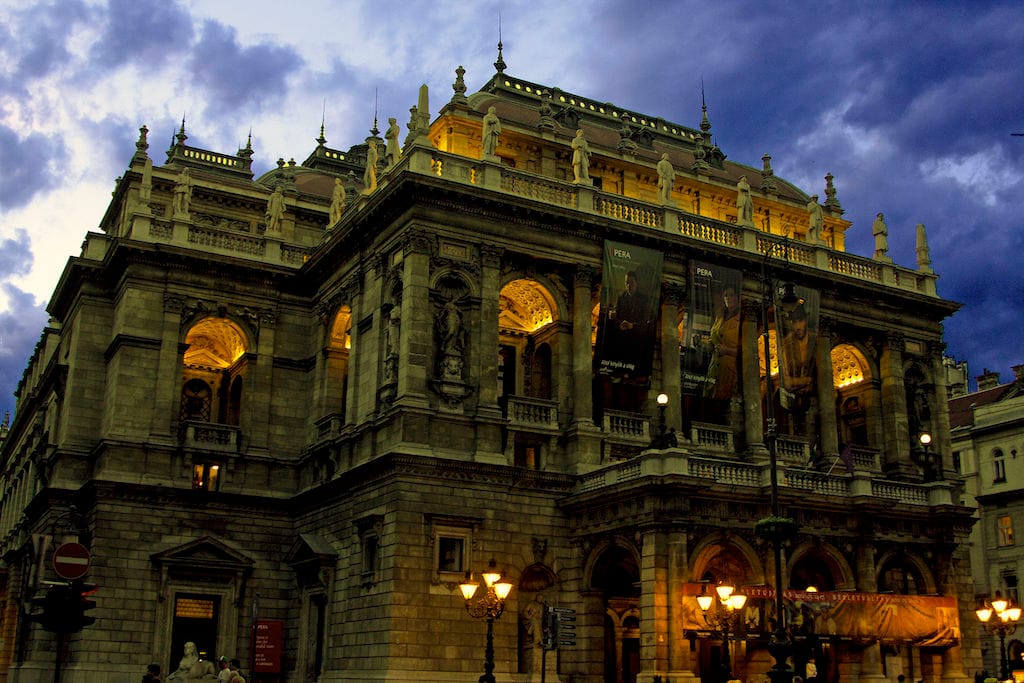The Performing Arts Dispatch: Hungarian State Opera

In 1873, when the Emperor of Austria and King of Hungary, Franz Joseph I, approved the construction of the Hungarian State Opera, his one condition was that it must not exceed the enormity of the Vienna State Opera. However, there was no stipulation placed on its beauty or opulence. The opera house was finally inaugurated in 1884 and enormity aside, the emperor had to concede that the auditorium, meticulously ornamented with gold décor and Baroque elements, outshone its Viennese counterpart. It remains one of the most arresting examples of neo-Renaissance architecture.
In a history spanning 138 years, the opera house—which took nine years to build—has endured wars, revolutions, renovations, changes in governments and administration, to continue to stage fine operatic work. It is also home to the Hungarian National Ballet, the only classical ballet company in the country. The Erkel Theatre became part of the Hungarian State Opera in 1951.
The imposing structure, located on Andrássy Avenue in Budapest, includes the foyer, the royal staircase, the Bertalan Székely Parlour, the Red Parlour, the Feszty Bar and the Opera Café. The symmetrical limestone facade follows a musical theme with sculptures of Ferenc Erkel, the father of Hungarian grand opera who founded the Hungarian State Opera Orchestra, and legendary composerpianist Franz Liszt.
The magnificent Neo-Renaissance structure that houses the three-storeyed auditorium was designed by the great Hungarian architect Miklós Ybl. The horseshoe-shaped auditorium boasts colours of gold and red, stately marble pillars, galleries and the Grand Staircase. The shining jewel of this diadem is the chandelier that illuminates the auditorium. Also designed by Ybl, it weighed three tonnes and was manufactured in Germany. It had to be run on gas, which prevented it from being completely put out, which created a beautiful play of light during performances. At present, a little lighter than before, it holds more than two hundred bulbs.
What is fascinating is how architect Ybl designed the auditorium in a way that would extend a relationship with the audience, reinforcing elements of opera culture and collective viewing. Audience members sitting in the boxes are essentially a part of the performance. Everything from their attire to mere presence can be a part of the events unfolding on the stage. Acquiring tickets to the same box every year became a measure of wealth and extravagance. Empress Elisabeth of Austria and Queen of Hungary is said to have viewed operas from the proscenium box near the orchestra pit. The Royal Box in the centre is now reserved for the three most important Hungarian heads of state and their guests. It is adorned with allegorical sculptures that represent the four operatic voices—soprano, alto, tenor and bass.
The inaugural gala in the autumn of 1884 would have been a sight to behold. In the presence of luminaries such as Erkel and Wagner, the opening acts of Bánk Bán, Hunyadi László and Lohengrin lit up the evening. The spectacular gala of 12th March 2022 too, after nearly five years of comprehensive refurbishment and modernisation, opened with Erkel’s Hunyadi László.
What started as a ten-month renovation project became a five-year-long process of revamping the whole building, along with the renovation and reopening of Erkel Theatre. The Eiffel Art Studios, the opera’s art complex innovatively housed inside an expansive railway maintenance and engineering site in Budapest, is now in operation, along with a new rehearsal space. The repertoire has been revamped, with premieres of 80 productions over the next four years lined up already. New technology, stage engineering and extensive equipment have been put in place as well. What captures the intention behind this assiduous undertaking is restoring the splendour of the opera house to its 19th century glory, in a modernised avatar.
Despite going through several restorations and reformation plans, the Hungarian State Opera has stood firm, never dampening the order of business. In the past decade, it has strengthened cultural ties across borders through international collaborations and tours.
In 2020, a successful tour to Sheikh Jaber Al-Ahmed Cultural Centre, Kuwait, was followed by myriad endeavours in the digital space in 2021. This year, the Hungarian State Opera has already had a gratifying run at Opera Neo, San Diego, USA. The second half of 2022 will witness their tryst with India as they make their debut with the NCPA. A fully staged production of Johann Strauss’s Die Fledermaus will be presented during the SOI Autumn 2022 Season, marking a highly anticipated collaboration between the Hungarian State Opera and the Symphony Orchestra of India. It is through strong cultural and artistic ties such as these that the opera house has not only been a national treasure of Hungary but also of the world.
By Aishwarya Bodke. This piece was originally published by the National Centre for the Performing Arts, Mumbai, in the October 2022 issue of ON Stage – their monthly arts magazine.





